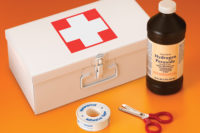When a person works in a hot environment, the body must get rid of excess heat to maintain a stable internal temperature of 97.9ºF to 99.5ºF. The body accomplishes this mainly by circulating warm blood to the skin (thermal convection) and by evaporating fluid off the skin (sweating). This system works quite well until the air temperature approaches body temperature. At that point, blood circulated to the skin cannot lose its heat, so sweating then becomes the main method for the body to cool down. Unfortunately, sweating is effective only if the humidity level is low enough to allow for evaporation and if the lost fluids and salts are adequately replaced. Risks are amplified in workers who: are 65 years of age or older; are overweight; have heart disease or high blood pressure; must wear occlusive, heat-trapping clothing (e.g., Tyvek suit); perform physically strenuous work; or take certain medications (e.g., anti-depressants, diuretics).
If the body cannot rid itself of excess heat, it will store it. When this happens, the body’s core temperature rises and the individual becomes sick. As the body temperature approaches 104ºF., the situation becomes life-threatening. At 106ºF, brain death begins. In 2006, OSHA recorded 24 heat-related deaths.
Types of heat stress
Broadly speaking, heat stress may manifest itself as heat exhaustion and/or heat stroke. Both conditions result from a combination of excessive body heat, loss of water, and depletion of salts. While heat exhaustion is less serious than heat stroke, if inadequately treated, heat exhaustion may progress to heat stroke.
Heat exhaustion
Signs and symptoms of heat exhaustion include:
- Heavy sweating
- Extreme weakness or fatigue
- Dizziness
- Confusion
- Nausea
- Clammy, moist skin
- Pale or flushed complexion
- Muscle cramps
- Dark urine
- Slightly elevated body temperature
- Fast and shallow breathing
- Treatment of a worker suffering from heat exhaustion consists of the following:
- Rest in a cool, shaded or air-conditioned area.
- Drink plenty of water or other cool, nonalcoholic beverages (e.g., Gatorade, Powerade).
- Take a cool shower, bath or sponge bath.
Heat stroke
Heat stroke is a catastrophic failure of the body’s ability to maintain a normal temperature. The body’s temperature rises rapidly, the sweating mechanism fails, and the body is unable to cool down. Ironically, the victim often loses the desire to drink fluids. When heat stroke occurs, body temperature can rise to 106ºF or higher within 10 to 15 minutes. At this point, if emergency treatment is not given, death is imminent.
Signs and symptoms of heat stroke include:
- Throbbing headache
- Dizziness and light-headedness
- Lack of sweating despite the heat
- Red, hot and dry skin
- Muscle weakness or cramps
- Nausea and vomiting
- Rapid heartbeat
- Rapid, shallow breathing
- Behavioral changes such as confusion, disorientation or staggering
- Seizures
- Unconsciousness
- If a worker is suffering from heat stroke:
- Call 911 immediately.
- Move the sick worker to a cool, shaded or air-conditioned area.
- Remove restrictive clothing and cool the worker using methods such as:
• Apply cool or tepid water to the skin and clothes (e.g., spray the worker with cool water from a hose.
• Fan the worker to promote sweating and evaporation.
• Place ice packs under the armpits and in the groin area.
• If able, the worker should slowly drink water, clear juice or a sports beverage.
Except for the mildest of cases, workers diagnosed with heat stroke should be admitted to the hospital for at least 48 hours to rapidly reduce body temperature and to monitor for complications.
Hydration is the key
In the course of a day’s work in the heat, a worker may produce as much as two to three gallons of sweat. Because so many heat disorders involve excessive dehydration, it is essential that water intake during the workday be about equal to the amount of sweat produced. Most workers exposed to hot conditions drink fewer fluids than needed because of an insufficient thirst drive. A worker should not depend on thirst to signal when and how much to drink. Instead, the worker should drink approximately eight ounces (one cup) of fluids every 15 to 20 minutes to replenish necessary fluids in the body. Water should be palatable and readily available to every worker. Individual drinking cups should be provided.
Heat-acclimatized workers lose much less salt in their sweat than do workers who are not adjusted to the heat. The average American diet contains sufficient salt for acclimatized workers even when sweat production is high. If salt replacement is required, the best way to compensate for the loss is to add a little extra salt to the food. Salt tablets should not be used.
Recommendations for employers
Whenever possible, workers should avoid exposure to extreme heat, intense sunlight, and high humidity. When these exposures cannot be avoided, employers should:
- Schedule maintenance and repair jobs in hot areas for cooler months.
- Schedule hot jobs for the cooler parts of the day.
- Acclimatize workers by exposing them for progressively longer periods to hot work environments.
- Gradually build up to heavy work.
- Reduce physical demands on workers.
- For example, use relief workers or assign extra workers for physically demanding jobs.
- Provide or encourage workers to wear light-colored, loose-fitting, breathable cotton clothing.
- Avoid non-breathable synthetic clothing.
- Provide cool water or liquids to workers.
- Workers should drink approximately 1 cup of water every 15-20 minutes.
- Drinks with large amounts of caffeine or sugar should be avoided.
- Provide rest periods with water breaks.
- Provide cool areas for use during break periods.
- Monitor all workers, especially those at increased risk of heat stress.
- Provide heat stress training that covers: worker risk, prevention, symptoms, the importance of monitoring oneself and coworkers for symptoms, treatment, and personal protective equipment.
To prevent heat stress, employers should provide training so workers understand what heat stress is, how it affects health and safety, and how it can be prevented.
References
1. http://www.cdc.gov/niosh/topics/heatstress/#_Heat_Stroke
2. https://www.osha.gov/Publications/osha3154.pdf



